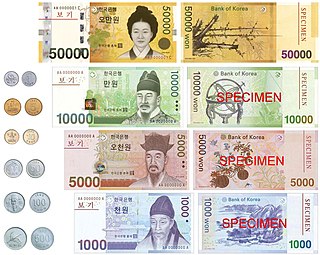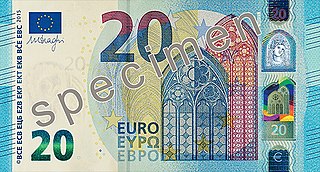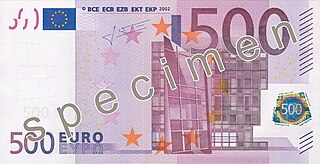
The Deutsche Mark, abbreviated "DM" or "D-Mark" ( ), was the official currency of West Germany from 1948 until 1990 and later the unified Germany from 1990 until the adoption of the euro in 2002. In English, it was typically called the "Deutschmark". One Deutsche Mark was divided into 100 pfennigs.
Federal Reserve Notes are the currently issued banknotes of the United States dollar. The United States Bureau of Engraving and Printing produces the notes under the authority of the Federal Reserve Act of 1913 and issues them to the Federal Reserve Banks at the discretion of the Board of Governors of the Federal Reserve System. The Reserve Banks then circulate the notes to their member banks, at which point they become liabilities of the Reserve Banks and obligations of the United States.

A banknote – also called a bill, paper money, or simply a note – is a type of negotiable promissory note, made by a bank or other licensed authority, payable to the bearer on demand. Banknotes were originally issued by commercial banks, which were legally required to redeem the notes for legal tender when presented to the chief cashier of the originating bank. These commercial banknotes only traded at face value in the market served by the issuing bank. Commercial banknotes have primarily been replaced by national banknotes issued by central banks or monetary authorities.

The South Korean won is the official currency of South Korea. A single won is divided into 100 jeon, the monetary subunit. The jeon is no longer used for everyday transactions, and it appears only in foreign exchange rates. The currency is issued by the Bank of Korea, based in the capital city of Seoul.

A counterfeit banknote detection pen is a pen used to apply an iodine-based ink to banknotes in an attempt to determine their authenticity. The ink reacts with starch in wood-based paper to create a black or blue mark but the paper in a real bill contains no starch, so the pen mark remains unchanged.

Security printing is the field of the printing industry that deals with the printing of items such as banknotes, cheques, passports, tamper-evident labels, security tapes, product authentication, stock certificates, postage stamps, and identity cards. The main goal of security printing is to prevent forgery, tampering, or counterfeiting. More recently many of the techniques used to protect these high-value documents have become more available to commercial printers, whether they are using the more traditional offset and flexographic presses or the newer digital platforms. Businesses are protecting their lesser-value documents such as transcripts, coupons and prescription pads by incorporating some of the features listed below to ensure that they cannot be forged or that alteration of the data cannot occur undetected.

Counterfeit money is currency produced outside of the legal sanction of a state or government, usually in a deliberate attempt to imitate that currency and so as to deceive its recipient. Producing or using counterfeit money is a form of fraud or forgery, and is illegal in all jurisdictions of the world. The business of counterfeiting money is nearly as old as money itself: plated copies have been found of Lydian coins, which are thought to be among the first Western coins. Before the introduction of paper money, the most prevalent method of counterfeiting involved mixing base metals with pure gold or silver. Another form of counterfeiting is the production of documents by legitimate printers in response to fraudulent instructions. During World War II, the Nazis forged British pounds and American dollars. Today, some of the finest counterfeit banknotes are called Superdollars because of their high quality and imitation of the real US dollar. There has been significant counterfeiting of Euro banknotes and coins since the launch of the currency in 2002, but considerably less than that of the US dollar.
The fifth series of the renminbi is the current coin and banknote series of the Chinese currency, the renminbi. They were progressively introduced since 1999 and consist of ¥0.1, ¥0.5, and ¥1 coins, and ¥1, ¥5, ¥10, ¥20, ¥50, ¥100 notes. The ¥20 banknote is a new denomination, and was added in this series. All banknotes in this series feature a portrait of Chinese Communist Party chairman Mao Zedong by artist Liu Wenxi. Therefore, this series of banknotes is also known as "Grandpa Mao" among the people.

The 500 yen coin is the largest denomination of Japanese yen coin issued for circulation. These coins were first struck in 1982 as the vending machine industry needed a higher valued coin for use in their machines. The denomination had previously been issued as paper currency which co-circulated with the new coins until 1994. Originally the 500 yen coin was made up of cupronickel, but was later changed to nickel brass, and then to bi-metallic to deter counterfeiting. This illegal practice has been a constant issue since the coin was first released due to its high purchase value. With a history spanning 3 imperial eras, 500 yen coins are also collectibles.

A currency-counting machine is a machine that counts money—either stacks of banknotes or loose collections of coins. Counters may be purely mechanical or use electronic components. The machines typically provide a total count of all money, or count off specific batch sizes for wrapping and storage.
This page is a glossary of notaphily. Notaphily is the study of paper money or banknotes.

Birds of Canada is the fifth series of banknotes of the Canadian dollar issued by the Bank of Canada and was first circulated in 1986 to replace the 1969 Scenes of Canada series. Each note features a bird indigenous to Canada in its design. The banknotes weigh 1 gram with dimensions of 152.40 by 69.85 millimetres. It was succeeded by the 2001 Canadian Journey series.
Cleaning cards are disposable products designed to clean the interior contact points of a device that facilitates an electronic information transaction. In order for the cleaning card to work properly in the device, the card resembles or mimics the material of the transaction media – such as a credit card, check, or currency. As the cleaning card is inserted and passed through the device, it will clean components that would normally come in contact with the transaction media such as readers, lenses, read/write chip and pins, belts, rollers, and paths. Cleaning card products are widely accepted and endorsed by device manufacturers and industry professionals. Many have developed their own cleaning cards to better clean their particular devices.

The ten euro note (10 €) is the second-lowest value euro banknote and has been used since the introduction of the euro in 2002. The note is used in the 25 countries which have it as their sole currency ; with a population of about 343 million. In July 2024, there were approximately 3 055 000 000 ten euro banknotes in circulation around the eurozone. It is the fourth most widely circulated denomination, accounting for 10.2% of the total banknotes. Estimates suggest that the average life of a ten euro banknote is about 1.5 years before it is replaced due to wear.

The twenty euro note (€20) is the third-lowest value euro banknote and has been used since the introduction of the euro in 2002. The note is used by the 25 countries and a population of 343 million as their sole currency, with 23 legally adopting it. In July 2024, there were approximately 4,818,000,000 twenty euro banknotes in circulation around the eurozone. It is the second most widely circulated denomination, accounting for 16.3% of the total banknotes. Estimates suggest that the average life of a twenty euro banknote is about two years before it is replaced due to wear.

The fifty euro note (€50) is one of the middle value euro banknotes and has been used since the introduction of the euro in 2002. The note is used by some 343 million Europeans and in the 25 countries which have the euro as their sole currency. In July 2024, there were about 14,712,000,000 fifty euro banknotes in circulation in the eurozone. It is by far the most widely circulated denomination, accounting for almost half (49.0%) of the total banknotes. Estimates suggest that the average life of a fifty euro banknote is about four years before it is replaced due to wear.

The one hundred euro note (100 €) is one of the higher value euro banknotes and has been used since the introduction of the euro in 2002. The note is used daily by some 343 million Europeans and in the 25 countries which have it as their sole currency. In July 2024, there were approximately 3 987 000 000 hundred euro banknotes in circulation in the eurozone. It is the third most widely circulated denomination, accounting for 13.3% of the total banknotes.

The five-hundred-euro note (500 €) is the highest-value euro banknote; it was produced between the introduction of the euro in 2002 until 2019. Since 27 April 2019, the banknote has no longer been issued by central banks in the euro area, but it continues to be legal tender and can be used as a means of payment. It is one of the highest-value circulating banknotes in the world, worth around 535 USD; 3 874 CNY; 83 598 JPY; 426 GBP, or 487 CHF as of April 2024. The note is used in the 26 countries that have the euro as their sole currency, with a population of about 343 million.
An intelligent banknote neutralisation system (IBNS) is a security system, that is used by banks, ATMs, retail establishments, vending machines and the cash-in-transit industry, to render stolen funds un-useable and easily identifable. Dye packs are inserted between bills in random bundles. If a bundle containing a dye pack is removed from a specified area, it explodes, releasing an indelible ink dye and possible array of additional chemicals. The conspicuous bright color stains on the bills, allow quick easy visual recognition of stolen money. Tracers and markers can also be added to the ink or bonding agent providing forensic evidence linking the criminal to the crime. Bonding agents have been used more recently.

The Frontier series is the seventh series of banknotes of the Canadian dollar released by the Bank of Canada, first circulated in 2011. The polymer banknotes were designed for increased durability and to incorporate more security features over the preceding 2001 Canadian Journey series. The notes feature images that focus on historic Canadian achievements and innovation. Printed on polymer, the 2011 Frontier series was the first series issued by the Bank of Canada printed on a material other than paper. The 2011 Frontier series is being followed by the Vertical series.

















